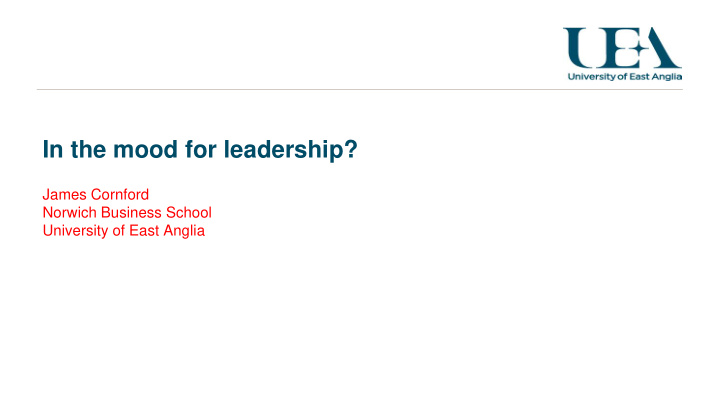



In the mood for leadership? James Cornford Norwich Business School University of East Anglia
Thoughts for the day • Pessimism of the intellect, optimism of the will (Antonio Gramsci) • …..a little mood music
Leadership • Process Not a possession or a position • Influence Not control • Goal directed Some kind of vision but not necessarily “a vision”
What is leadership today? • Leadership: Leader-centric to follower-centric Leader-centric: successful leaders can improve their followers performance Follower-centric: leaders performance is improved by their followers • From situational or contingent to constructed Contingent: finding a style that is ‘fit for purpose’ Constructing a “purposeful fit” between leader style and situation including followers (by changing both) • From transactional to transformational Transactional = I scratch your back and you scratch mine Transformational = we are going on a journey together
The Arts of Leadership • The Pictorial-visionary, “Paint me a picture” • The Performative-dramatic, “Make a song an dance about it” • The Martial-tactical, “Use the opposition” • The Philosophical-identity “Who is we?” Source: Grint 2001
Leadership and Followership 3 4 White Elephant Wheelwright Theocracy Heterarchy and Socratic Disciple Followers Leaders Constructive Consent Responsible Followers Constructive Dissent Increasing Commitment to Community Goals 1 2 Emperor Cat Herder Hierarchy and Superior Anarchy and No Leader Leaders Irresponsible Followers Independent Individuals Destructive Consent Destructive Dissent Increasing Independence from Leader Source: Grint 2005: 36
Systems Theory • 1940s and 50s General Systems Theory – Controls • 1950 and 60s Cybernetics and Feedback – Steering • 1970s Catastrophic Systems, Cusps and Inflections – Tuning • 1980-1990s Chaos theories - unpredictability and instability – Damping • 1990s-2000s Complex Adaptive Systems – Strange Attractors
Complex adaptive systems? • In science A complex macroscopic collection of relatively similar and partially connected micro-structures – formed in order to adapt to the changing environment, and increase its survivability as a macro- structure. • Hang about - that’s us! • Complex? Adaptive? complex in that they are dynamic networks of interactions, and their relationships are not aggregations of the individual static entities adaptive in that the individual and collective behaviour mutate and self-organize corresponding to the change-initiating micro-event or collection of events Source: Drawing on https://en.wikipedia.org/wiki/Complex_adaptive_system
Leading Complex Adaptive Systems
Far from agreement 5 The Stacey Matrix Decision Making 1. Telling - Simple 4 2. Selling – Complicated, political 3. Consulting – Complicated, exploratory 4. Co-creating – Complex, interaction 2 Close to agreement 5. Chaos – … no decision 1 3 Where is your issue? Close to certainty Far from certainty
Transformational leadership • When you stop doing the things you thought were essential ….. • …and start doing the things you thought were impossible Apologies to Mike Martin
What is mood? • Some related concepts Feeling (inward at the moment) Emotion (outward display of feeling) Affect (psychologists term for feeling or emotion) Mood (relatively settled pattern of feeling/emotion) Atmosphere (shared mood of group) • Linking internal and external, biological and social “Emotion has a source outside of the self in its relation with others and is internally experienced as a function of active being” (Barbalet, 2001: 187) Mood is bio-chemical – it can be altered but… Mood is “contagious” – founded in social relationships Mood creates Atmosphere – a shared mood
Measure your mood: a mood wheel Activation Alert Tense Excited Nervous Elated Stressed Happy Upset Pleasant Unpleasant Sad Contented Depressed Serene Bored Relaxed Fatigued Calm Deactivation
The Effects of Affect: Leaders affect Followers Individual outcome Team members’ mood Group Outcomes Leaders Mood Group affective Performance tone Potency Source: Volmer, 2012
The Effects of Affect 2: Followers Affect Leaders Follower Mood Leader Effectiveness Leader Mood • “affect -based processes may be a key mechanism by which followers influence leader affect and leadership outcomes” (Teea et al., 2013: 512)
Moods and Leadership • Panic Typical moods of IT project (Ciborra, 2001) • Boredom • What are the typical moods and atmospheres of successful social change? • How do we work on mood? As leaders As followers
How Do You Feel About Leadership in Varied Situations • For each area of the Stacey Matrix – 1 to 5 • Draw an emoticon (or write a word) to represent how you feel about leadership • Remember that it is leadership You may be a leader You may be a follower
Sum up • Influence (shape pattern not programmes) • Transformation (do something impossible) • Understand the context (simple, complicated, complex, chaotic) • Leading the mood as much as the cognition Reassurance, Challenge, Stimulation, Calming • So, are you in the mood for leadership? As a leader? As a follower?
References • Barbalet, J. (2001) Emotion, Social Theory and Social Structures . Cambridge: CUP. • Ciborra, C. U. (2001) In the Mood for Knowledge A new study of improvisation, LSE Dept. of IS Working Paper 94. • Fineman, S. (2003) Understanding Emotion at Work . London: Sage. • George, J. M. (2000) Emotions and Leadership: The Role of Emotional Intelligence, Human Relations, 53 , 8: 1027-1055. • Grint, K. (2001), The Arts of Leadership . Oxford: OUP. • Grint, K. (2005), Leadership: Limits and Possibilities . Basingstoke: Palgrave. • Thompson, M. and Willmott, H. (2015) the social potency of Affect: Identification and power in the immanent structuring of practice, Human Relations, 68: 1-24. • Stacey, R. D. (2002) Strategic management and organisational dynamics: the challenge of complexity (3rd ed.). Harlow: Prentice Hall. • Teea, E., Ashkanasy, N. M. Paulsen,N. (2013) The influence of follower mood on leader mood and task performance: An affective, follower-centric perspective of leadership, The Leadership Quarterly , 4(4): 496 – 515 • Volmer, J. (2012) Catching Leaders’ Mood: Contagion Effects in Teams Administrative Science , 2, 203-220.
Notes:
Recommend
More recommend